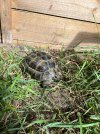idcowden
Member
Actually it isn't. You state what you think people should do, but there isn't much about *why* as far as I can see. Why isn't letting them do what they want to do, a good idea?This is EXACTLY what a person should not do and this is explained in the brumation thread very clearly.
I didn't ask for help. I asked for opinions - usually those come with some justifications. "you are doing it wong" isn't an answer that I would accept from anyone I work with, let along anyone on a hobby forum. People only learn from understanding *why* something might be a bad idea, not from being told.I can't understand why you refuse to accept advice on this matter from someone who has decades of experience with it. Is it some sort of pride thing? Stubbornness? It makes no sense. Why ask for help and then react as you have?
I also don't quite understand how you propose that I separate my tortoises given the absence of space to do so, unless you have some extra-dimensional solution that I am not aware of.
To be fair, I have considered separating them. There is a small possibility which is turning what is currently a flower bed into a run extension and then altering what is currently a cold frame into a two compartment box. The complication is the roots for the wisteria and the apple tree that would be in the middle of the run. Not to mention the guineapig graveyard.








